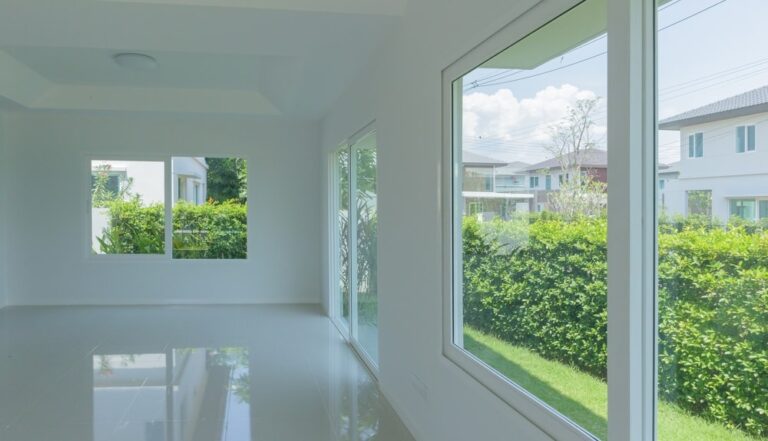Many homeowners hate winter for a variety of reasons, and one of the most common complaints is that heating costs are too high. In order to stay comfortable and take the chill out of your indoor air, you need to run your heating system. However, all the hot air might be escaping your home, and your windows are one of the biggest culprits.
The best time to perform window insulation for winter is before the temperatures plummet. If you have drafty windows that are older, your best bet is to replace those old windows with new, energy-efficient options. Since not everyone can take on a home improvement project right away, the home improvement contractors at Pinnacle Home Improvements are here with winter window insulation tips.
Contact us for a window replacement in Georgia, and read on to learn ways to insulate your windows for winter until you’re ready to start this project.
Importance of Window Insulation
If you live in a colder climate, you need to know how to insulate windows for winter. Insulation provides many benefits for you and your family at home.
Reduced Energy Bills
Heating your home to provide respite from the cold air outdoors comes at a significant cost. When you have old windows with window drafts, you’re essentially paying to let the heat escape to the outdoors. Winterizing your windows allows you to keep heated air inside your home and maintain your comfort, not to mention keeping your heating bill from going sky-high.
Comfort During the Cold Season
Winter months bring chilly air, and when cold drafts are getting in your home, you may be forced to bundle up with added layers indoors. Insulation helps keep your house warm and cozy.
Better Protection for Your Home
Your home is your greatest investment, and keeping it in prime condition will protect its value. Condensation and moisture can develop on your windows when they lack proper insulation. When the issue is prolonged, you increase the risk of mold, mildew, and wood rot destroying your window frames. Insulation can help you prevent these issues and secure your home.
Methods to Insulate Windows from Cold Air
The best way to have energy-efficient windows is to replace them, though not everyone can plan for this home improvement ahead of winter. If you need to update your insulation for winter, you can use a few methods that will help you reduce energy costs while staying more comfortable behind closed doors.
Use Window Film Insulation
You can insulate your windows from cold air by using a plastic film or even bubble wrap cut to fit on the window pane or window frames. This helps keep out drafts of air and improves comfort while making your home more energy efficient. However, it is not the best method to insulate windows.
Apply Weatherstripping
Choose heavy-duty weather stripping to block air drafts. When you seal areas with weatherstripping, it can fill in the gaps. Weather stripping that adheres in the same way as double-sided tape is the easiest to apply to the gaps you find. If your windows have old weatherstripping, this may be all you need to prevent heat loss and add an extra layer of protection from the cold.
Get New Windows
You can’t put off the need to replace your windows forever, and there are amazing benefits to choosing double or triple-pane windows. One of the biggest advantages is that they will keep you more comfortable during the winter months while preventing you from wasting heated air and energy. You won’t have to work hard to insulate your windows or window frames, as they will already be insulated to help your home stay at your preferred temperature in any season.
DIY vs Professional Installation
While you can insulate windows yourself to save money, it may not always be a good idea to do it yourself. On the one hand, you can potentially save money when you insulate your windows yourself, especially if you’re adding new weather stripping. However, if you want to replace your windows rather than insulate them, it is best to have professionals replace your windows.
There may also be issues with the warranty from the manufacturer on your windows. Some specify that DIY installations can void the warranty. A good rule of thumb to remember is that window replacements will require the expertise of window replacement contractors. If you have an older home, there may be dangerous materials such as asbestos or lead paint that must be dealt with by a pro.
Additionally, to insulate windows and properly protect the structure of your home, a professional will have the skills needed to seal them for the best energy efficiency. Even if you have strong DIY skills, replacing windows is a job for professionals.
That’s where Pinnacle Home Improvements comes in, with professional window services that give you a seamless installation experience. It starts with an expert consultation where we will help you choose from an array of quality materials that can enhance your home’s aesthetics, efficiency, and structural integrity. Our licensed and trained installers can then replace windows, ensuring proper sealing and insulation as per all local building codes and manufacturer requirements.
Additional Tips for Winterizing Windows
You can do a few other things to winterize your windows and get ready for the cold months ahead. When used in conjunction with other tips, you can quickly improve your home’s insulation.
Seal Gaps and Cracks Around Your Windows
Even newer windows may develop gaps and cracks around them. This is why it’s so important to inspect them once a year and seal any cracks and gaps you may see around the frames. Caulk, particularly a silicone-based variety, is a great way to fill in these areas. Combined with weatherstripping along the window sashes, you can create a tight seal when your windows are closed.
Rely on Window Coverings
Thermal curtains, blinds, and cellular shades can also help keep you warmer indoors. The downside of thermal drapes is that they block out the sunlight, requiring you to rely on artificial light to illuminate your interior during the day.
Installing Storm Windows
Installing storm windows is another way to provide another layer of insulation. Storm windows will help you reduce heat loss and improve your home’s energy efficiency, but only if you’ve fit them properly and caulked around the frame first.
Add Low-E Coatings
Modern windows have protective Low-E coatings that improve energy efficiency, though that doesn’t mean you can’t add them to your existing windows. These coatings will be more effective than bubble wrap, won’t hinder your aesthetic, and will add value to your home.
Exploring High-Efficiency Window Replacements
As a homeowner, you should always focus on ways to improve your home to maintain your comfort and your property value. When you replace older windows with new varieties that focus on energy efficiency, you gain significant energy savings over the long term.
Double and triple-pane windows are incredibly adept at protecting your home. They feature an extra layer of glass separated by nontoxic gas fills that insulate and dampen sound. When you choose these windows, they improve your comfort by keeping out drafts, allowing you to regulate the temperature in your home.
It’s a good idea to schedule a professional consultation to learn more about your options and get a free quote. You’ll be able to discover how modern windows can help you insulate your home for winter.
How to Tell If You Have Drafty Windows That Need Insulation
The last thing you want to do is wait until the coldest day of the year to try to insulate your windows. Ideally, you should check before the cold sets in to help you identify problem areas that can be insulated with weatherstripping or caulk the cracks and gaps.
You can use a piece of paper or a dollar bill, closing the window on it while it is sticking out from the edge. If you can pull it out without any resistance, you have air leaks coming from that window. Some people use candles or incense, looking for the flame or smoke to flicker, while others just hold up their hands around the window frame. If you can feel cool air blowing in around the frame, there is a draft.
Performing these checks on all of your windows can help you identify which ones may need to be prioritized for winterization or replacement. It’s also a good idea to schedule a professional inspection where your home can be checked for air leaks. While windows and doors are the most common sources for air to escape or enter your home, there may be other areas that need attention, like your roof or attic. Contact Pinnacle Home Improvements to take care of any drafts ahead of winter and have greater peace of mind at home.















